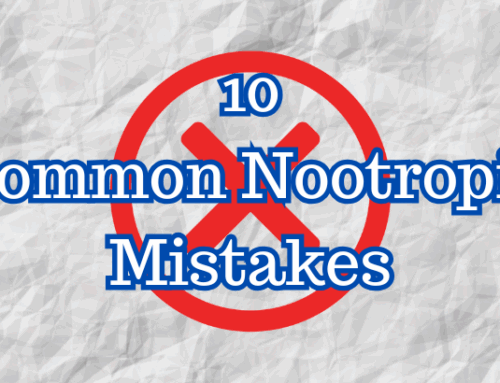Coluracetam is a fascinating substance that has gotten some attention from the nootropics community in recent years. Although more research needs to be done to fully understand coluracetam's role as a nootropic, users often claim that it can improve memory and mood, decrease anxiety, and increase focus.
In this article we're going to take an in-depth look at coluracetam. We'll explore its benefits, safety, dosage, and more. But first, let's see what coluracetam is.
What Is Coluracetam?
Of all the nootropics that are available today, coluracetam is one of the most recent to hit the scene. It was first developed by the Japanese pharmaceutical company Mitsubishi Tanabe as a treatment for Alzheimer's.1 Coluracetam was first synthesized by modifying the the molecule of a well-known nootropic: piracetam. They're both in the same class of substances called racetams.
Coluracetam has been scientifically studied for its potential as a treatment for depression and anxiety. The San Diego biotechnology company BrainCells, Inc. investigated using coluracetam for both of these. BrainCells, Inc. specializes in developing compounds for the treatment of central nervous system (CNS) diseases. Phase 2 clinical trials showed that coluracetam – when dosed three times a day – may be effective at treating some people who suffer from both depression and anxiety.2
Developed under the code names BCI-540 and MKC-231, coluracetam has been shown to affect certain neurotransmitters in the brain that are associated with memory and learning. Acetylcholine is one such neurotransmitter.
Coluracetam has been shown to increase high-affinity choline uptake (HACU).3 HACU is involved in acetylcholine synthesis. Increasing HACU can increase acetylcholine levels in the brain.4 This goes a long way in explaining many of the memory-enhancing effects that coluracetam users have reported.
Coluracetam Benefits
 Unfortunately, aside from the phase 2 clinical trial mentioned above, coluracetam has not really been scientifically studied in humans. While preliminary investigations have shown it to be safe and possibly effective at treating certain conditions, more human research is needed. However, several animal studies have been done on coluracetam. The results have been promising and support what many nootropic users have been saying.
Unfortunately, aside from the phase 2 clinical trial mentioned above, coluracetam has not really been scientifically studied in humans. While preliminary investigations have shown it to be safe and possibly effective at treating certain conditions, more human research is needed. However, several animal studies have been done on coluracetam. The results have been promising and support what many nootropic users have been saying.
A 1994 study done on mice showed that coluracetam was able to improve memory.5 Mice were given a chemical that produces memory deficits and then given one of three nootropic compounds, coluracetam being one of them. The results of this study showed that coluracetam improved the working memory deficits caused by the chemical and that coluracetam increased choline uptake (HACU).
A rat study published in 1998 showed coluracetam to have neuroprotective properties.6 Researchers wanted to see what effect it had on glutamate neurotoxicity. They found that exposure to coluracetam for 12-24 hours ameliorated glutamate cytotoxicity.
In 2008, researchers wanted to see if coluracetam could improve the performance of learning-impaired rats in a water-maze task.7 They reported significant improvements in the rats that were given coluracetam. The researchers also noted that coluracetam could have “long-lasting pro-cognitive effects.”

A similar study done over a decade earlier showed similar results. In 1996, researchers tested memory-impaired rats to see if coluracetam would help them through the Morris water maze.8 This is a test that scientists commonly use to study the behavior of rats. The researchers found that the rats given coluracetam showed significant improvements in learning. They also noted that coluracetam did not produce any significant side effects.
The last rat study I'll mention here was done in 2007.9 Researchers wanted to see if coluracetam had any effect on the behavioral deficits caused by repeated phencyclidine (PCP) exposure. PCP is a drug that can cause hallucinations, delusions, and full-blown psychosis in humans. The researchers found that the rats given coluracetam showed a significant reduction in cognitive impairment. They suggest that coluracetam be studied as a possible treatment for schizophrenia.
More human studies are needed before coluracetam's nootropic benefits can be conclusively stated. But the animal studies above definitely support a lot of the claims coluracetam users have made. Here are some of the nootropic benefits of coluracetam that are commonly reported:
- Improved memory
- Increased focus
- Improved learning
- Improved mood
- Decreased anxiety
Coluracetam Dosage & Safety
![]()
There have not yet been any human studies done to figure out the optimal dosage of coluracetam. Users often report nootropic benefits from taking as little as 20 milligrams (mg). Others say they need a dose in the 40-80 mg range to notice the nootropic effects of coluracetam.
While users often report a nootropic effect after one dose, many say coluracetam works best when taken daily. It's not uncommon for coluracetam users to dose two-to-three times a day. In the human trial discussed earlier, the participants who took coluracetam three times a day had superior results to those who only took it once daily.
Although there haven't been any human studies done to assess the optimal dosage of coluracetam, one human study has been done that tested its safety.10 Coluracetam passed the safety testing of phase 2 clinical trials. Participants were given either 80 mg of coluracetam a day (q.d.) or 80 mg three times a day (t.i.d.) for six weeks.
Since coluracetam passed through phase 2 safety testing, it seems to be safe to take at a dosage of up to 240 mg a day for six weeks. And there are a number of anecdotal reports of users taking higher dosages and for longer periods of time with no ill effects.
As always, you should consult with a licensed healthcare professional before starting any new drugs, supplements, diets, exercise programs, or behavioral routines. Most doctors don't know very much about nootropics so you may have to educate yours. The References section at the bottom of this page is a good place to start.
Stacking Coluracetam
![]() Many coluracetam users take it as part of a nootropic stack. Stacking simply means taking two-or-more nootropics together to increase their effectiveness.
Many coluracetam users take it as part of a nootropic stack. Stacking simply means taking two-or-more nootropics together to increase their effectiveness.
The most-common thing that coluracetam users stack it with is a choline source like alpha-GPC or CDP-choline. Since coluracetam increases high-affinity choline uptake (HACU), taking a choline source with it may further increase acetylcholine levels in the brain. But coluracetam isn't the only racetam that is commonly stacked with a choline source. Others like piracetam, aniracetam, and many more are often taken with a choline source to boost their effects.
Coluracetam users have reported stacking it with a variety of other nootropics including various racetams and adaptogens. I couldn't find any reports of negative effects from stacking coluracetam with other nootropics. It seems to be tolerated as well as most of the other popular nootropic racetams.
Where To Buy Coluracetam

The best place to buy coluracetam online is from Pure Rawz, hands down. They offer this hard-to-find nootropic in three different forms: powder, liquid, and tablets. Their tablets are dosed at 30 mg each and are sold in two different quantities. Though many nootropic users prefer tablets, Pure Rawz does offer coluracetam as a liquid and as a powder for those of you who prefer these forms. In other words, however you want it, they've got it. In addition to having high-quality products, Pure Rawz has an astonishing selection of nootropics and other substances. Their prices are reasonable, shipping discreet, and they have good customer service. Highly recommended.
If you're a Science.bio customer, they offer coluracetam in powder form that comes in 1-gram (1,000 mg) jars. Science.bio also offers a wide selection of other nootropics, but most only as powders. If you prefer your nootropics in powder form, Science.bio has reasonable prices, fast shipping, and great customer service.
Conclusion
Coluracetam is an interesting substance that shows a lot of promise as a cognitive enhancer. While more human studies are definitely needed, the human and animal studies that have been done are very encouraging.
This is one of the few nootropic racetams that I haven't personally tried yet. Have you? If so, I'd love to hear about your experience with coluracetam in the comments section at the bottom. And if you haven't already, sign up for the Nootropics Zone newsletter below to learn about dozens of brain-boosting substances.
To learn more about nootropics, sign up for the Nootropics Zone newsletter. You'll get the free gift, The Ultimate Nootropics Quick Reference Guide.
References
1Coluracetam. (n.d.). Wikipedia.org. Retrieved May 17, 2024 from https://en.wikipedia.org/wiki/Coluracetam
2BrainCells Inc. announces results from exploratory phase 2a trial of BCI-540 in depression with anxiety. (2010, June 14). Retrieved August 14, 2020 from https://web.archive.org/web/20111121081645/http://www.braincellsinc.com/wp-content/uploads/2010/06/BCI-PR-06142010.pdf
3Takashina, K., Bessho, T., Mori, R., Eguchi, J., & Saito, K. (2008). MKC-231, a choline uptake enhancer: (2) effect on synthesis and release of acetylcholine in AF64A-treated rats. Journal of Neural Transmission (Austria), 115(7):1027-35.
4Ray, B., Bailey, J., Simon, J., & Lahiri, D. (2012). High-affinity choline uptake (HACU) and choline acetyltransferase (ChAT) activity in neuronal cultures for mechanistic and drug discovery studies. Current Protocols in Neuroscience, 60(1):7.23.1-16.
5Murai, S., Saito, H., Abe, E., Masuda, Y., Odashima, J., & Itoh, T. (1994). MKC-231, a choline uptake enhancer, ameliorates working memory deficits and decreased hippocampal acetylcholine induced by ethylcholine aziridinium ion in mice. Journal of Neural Transmission, 98:1-13.
6Akaike, A., Maeda, T., Kaneko, S., Tamura, Y. (1998). Protective effect of MKC-231, a novel high affinity choline uptake enhancer, on glutamate cytotoxicity in cultured cortical neurons. Japanese Journal of Pharmacology, 76(2):219-22.
7Bessho, T., Takashina, K., Eguchi, J., Komatsu, T., Saito, K. (2008). MKC-231, a choline-uptake enhancer: (1) long-lasting cognitive improvement after repeated administration in AF64A-treated rats. Journal of Neural Transmission (Austria), 115(7):1019-25.
8Bessho, T., Takashina, K., Tabata, R., Ohshima, C., Chaki, H., et al. (1996). Effect of the novel high affinity choline uptake enhancer 2-(2-oxopyrrolidin-1-yl)-N-2,3-dimethyl-5,6,7,8-tetrahydrofuro[2,3-b] quinolin-4-yl)acetoamide on deficits of water maze learning in rats. Arzneimittelforschung, 46(4):369-73.
9Shirayama, Y., Yamamoto, A., Nishimura, T., Katayama, S., & Kawahara, R. (2007). Subsequent exposure to the choline uptake enhancer MKC-231 antagonizes phencyclidine-induced behavioral deficits and reduction in septal cholinergic neurons in rats. European Neuropsychopharmacology, 17(9):616-26.
10Safety and effectiveness study of BCI-540 versus placebo in the treatment of Major Depressive Disorder with concomitant anxiety. (2011, Oct. 24). Retrieved August 14, 2020 from https://clinicaltrials.gov/ct2/show/NCT00621270
[This article was originally published on July 27, 2015. Updated May 17, 2024.]







What would you recomend for ADD ?